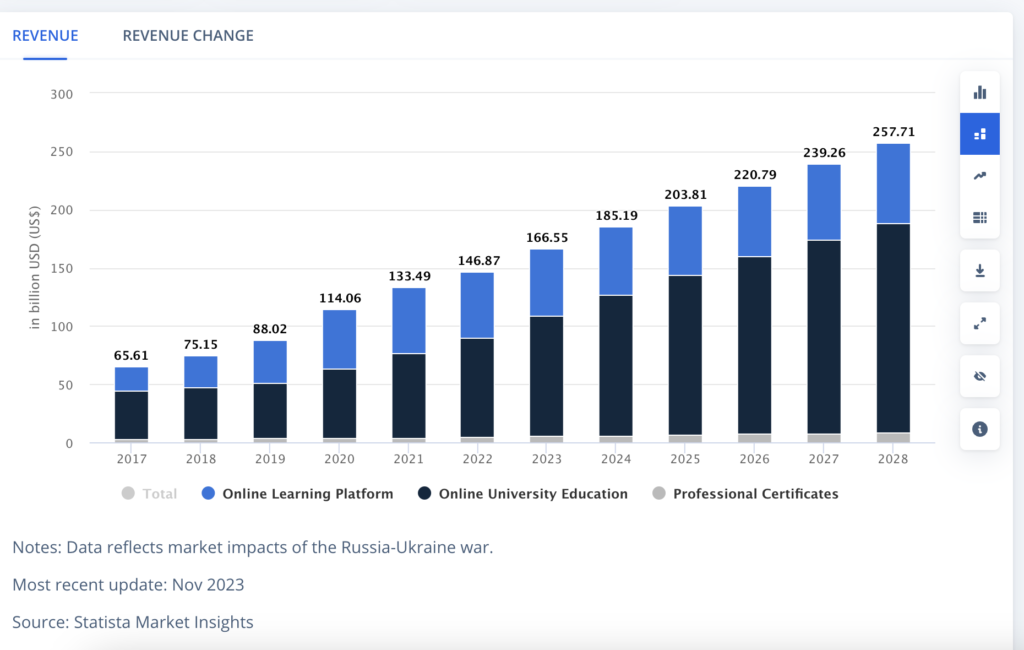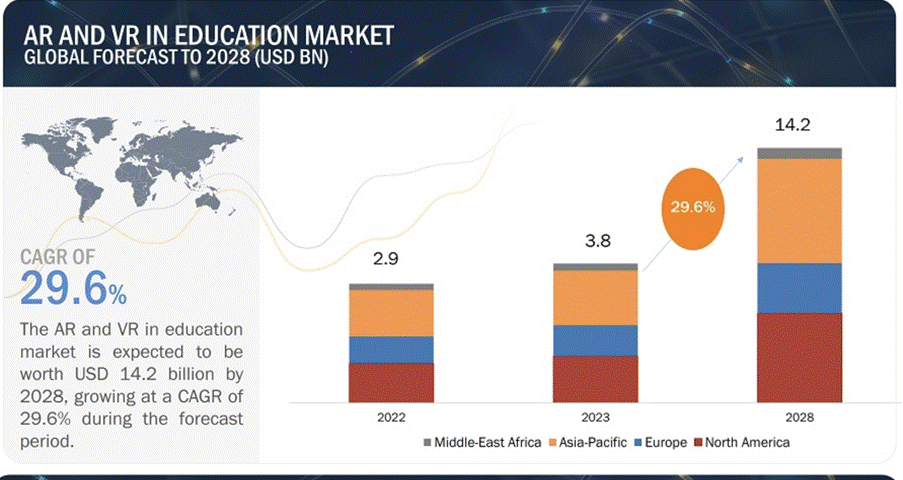In the ever-evolving landscape of education, a paradigm shift is underway, and at its core is the dynamic duo of video and live streaming. As we navigate the digital era, these technologies emerge as powerful catalysts, reshaping how we teach and learn.
Let’s explore the exciting realm where education meets innovation, exploring why video and live streaming are weaving the fabric of the future of education and how it can make education more engaging for learners.
Table of Contents
What is Video & Live Streaming?
Video streaming is a technology that continuously transmits video and audio content over the internet in real-time. This allows users to watch videos without downloading the entire file beforehand. Popular video streaming services, like YouTube, Amazon Prime, and Hulu, utilize this technology to deliver on-demand content to users worldwide.
Live streaming, a subset of streaming, involves broadcasting live events or activities over the internet as they happen. It allows real-time interaction between the content creator and the audience.
Live streaming is commonly used for various purposes, including live news broadcasts, sports events, gaming, and educational webinars. Platforms like Facebook Live, YouTube Live, Zoom, and Twitch provide tools for individuals as well as organizations to broadcast live content.
How are Video & Live Streaming Changing the Face of the Education Industry?
Video streaming and live streaming technologies are revolutionizing the education industry, transforming how students learn and educators teach. Let’s delve into this realm where education meets innovation, exploring why video and live streaming are weaving the fabric of the future of education.
Beyond Classroom Walls
Statistics reports reveal that online education is being adopted by more and more people, with a global market projected to reach $319.167 billion by 2025. The traditional classroom setup gives way to a more flexible, accessible model.
Source: (Statista)
Video content serves as the bridge that spans geographical boundaries, allowing learners to engage with educational materials at their own pace. Whether it’s lectures, tutorials, or demonstrations, students can now access knowledge from the comfort of their homes.
Dynamic Engagement and Interactivity
In the state of video in education study, almost 98% of respondents agreed that streaming content enhances the overall learning experience in higher education. Education is no longer confined to static textbooks. Video content introduces a dynamic and interactive element to learning. Visual aids, simulations, and demonstrations bring subjects to life, catering to diverse learning styles.
Personalization at its Core
The cookie-cutter approach to education is making way for personalized learning experiences. Video content can be curated to suit individual learning needs, allowing students to revisit concepts or explore advanced topics. Live streaming takes personalization further by fostering real-time connections, facilitating one-on-one sessions, and building a sense of community among learners.
Breaking Down Economic Barriers
Organizations save 50-70% when replacing instructor-led training with eLearning methods. The cost-efficiency of video and live streaming in education is a game-changer. Institutions can reduce expenses associated with traditional teaching methods, making education more accessible. Travel costs and venue expenses are minimized through live streaming, democratizing education, and ensuring that financial constraints do not restrict quality learning.
Embracing Technological Advancements
Market and Markets report shows that the educational virtual reality market reached 3.8 billion in 2023. The virtual classroom market is estimated to reach around 14.2 Billion by 2028; the growth is estimated at 29.6% during the forecasted period.
Source: (MarketsAndMarkets)
Technological strides are propelling education into the future. High-speed internet, augmented reality, and virtual reality technologies enhance the immersive learning experience. Live streaming becomes a conduit for real-time, interactive experiences, breaking down the barriers between the physical and digital realms.
Global Connectivity
According to a UNESCO report, 81% of higher education institutions believe international collaboration is essential for addressing global challenges. Video and live streaming open the doors to global collaboration.
Institutions can effortlessly connect with experts, guest lecturers, and students worldwide, fostering a rich tapestry of cultural exchange. The global reach of education becomes a reality, transcending borders and fostering a diverse and interconnected community of learners.
Harnessing Data for Improvement
Analytics tools embedded in a video streaming platform like Netflix or Hulu offer valuable insights into student engagement and performance. Educators can leverage this data to refine and enhance their teaching methodologies, creating a continuous feedback loop that ensures the educational journey is tailored to the evolving needs of the learners. A study by Blackboard found that 70% of students feel positively about using learning analytics to enhance their learning experience.
Accessibility and Flexibility
On-demand video content allows students to access lectures, tutorials, and educational materials conveniently. This flexibility is very beneficial for learners with diverse schedules as well as commitments.
Real-time live streaming facilitates synchronous learning, enabling students to participate in live lectures, discussions, and interactive sessions from anywhere in the world.
Enhanced Engagement and Interactivity
Visual aids, animations, and dynamic content enhance engagement, catering to different learning styles. Students can pause, rewind, and review material as needed.
Real-time interactions, live Q&A sessions, and collaborative activities foster engagement and develop a sense of immediacy, making learning more interactive and dynamic.
Personalized Learning Experiences
Streaming content can be customized to meet individual learning requirements, empowering students to progress at their own pace and revisit challenging concepts. One-on-one sessions, small group discussions, and personalized feedback during live sessions contribute to a more tailored and individualized learning experience.
Cost-Efficiency and Accessibility
Institutions can reduce costs associated with traditional teaching methods, such as printing materials. Students save on commuting as well as accommodation expenses.
Virtual classrooms eliminate the need for physical spaces, reducing infrastructure costs. Students can access classes without geographical constraints, promoting inclusivity.
Technological Advancements
High-quality production values and integration of augmented reality (AR) and virtual reality (VR) technologies enhance educational content’s visual and immersive aspects. Advancements in live streaming technologies provide real-time, high-quality interactions, bringing experts and educators worldwide into the virtual classroom.
Global Reach and Collaboration
Educational content can be shared globally, promoting cross-cultural understanding and collaboration. Institutions can collaborate with experts and guest lecturers worldwide, exposing students to diverse perspectives and fostering a global learning community.
Data-Driven Insights
Analytics tools help educators identify popular content, track student engagement, and refine teaching strategies based on data-driven insights. Real-time analytics during live sessions facilitates immediate feedback, enabling educators to promptly adapt their approach and address student needs.
Adaptability and Continuous Learning
Archived videos serve as valuable resources for continuous learning, allowing students to review material and refresh their understanding. The real-time nature of live sessions encourages adaptability, as educators can respond to current events, questions, and emerging trends instantly.
Ending Note
The future of education is woven with the threads of video and live streaming. While these technologies undoubtedly hold transformative potential, it’s crucial to recognize that a blended approach, incorporating both digital and traditional methods, maybe the most effective way forward.
As we navigate this exciting era of educational evolution, one thing is clear – the tapestry of learning is becoming more vibrant, accessible, and interconnected. Welcome to the future of education – where innovation meets inspiration.
Author Bio:
Dilshad Durani is a seasoned Digital Marketer and Content Creator currently contributing her expertise to the dynamic team at Alphanso Technology, a leading company specializing in Eventbrite clone and open-source event ticketing system development. She is curious to learn new things and is passionate about helping people understand market trends, changing marketing approaches, business ethics, and more with her writing.





